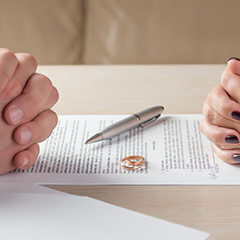Pennsylvania Appellate Court Affirms Acceptance of the Wife’s Gross Sales Valuation Method for the Marital Business but Remands for Double Counting of Business Assets
October 12, 2022 | Divorce Litigation
 Snyder v. Snyder
Snyder v. Snyder
In this Pennsylvania divorce case, the Superior (Appellate) Court affirmed the trial court’s decision to use the wife’s method of valuing a marital asset business after the master concluded that the wife’s testimony was credible and that her valuation method “accurately valued the business.” The Superior Court also concluded that the trial court had double-counted some business assets by including them in the value of the business and again as separate items in the marital estate.
In May 1993, before the marriage in 1995, the husband formed a corporation, RAS BAR Inc., and was the sole shareholder of the same. In September 2004, during the marriage, a deed was transferred to the husband for real estate in Sunbury, Pa., known as the Peppermint Lounge. The husband testified that he paid $310,000 for the real estate and liquor license. In February 2009, the Peppermint Lounge burned down. The insurance proceeds of $809,720 were used to pay off the mortgage on the marital residence. Neither party could show where the proceeds went, but the husband had complete control of the funds, claiming $491,000 was spent on the new addition to the house, but no proof was provided. The parties agreed that the addition was completed and was extensive, but there was still no proof of how much was spent on the addition.
In March 2016, the husband moved the liquor license to Christopher Allen Snyder, t/a Squeeze-In. “Husband and son submitted a retail space lease contract to lease the ‘Squeeze-In’ real estate for $1.00 per year on March 1, 2016.” All of the stock of RAS BAR Inc. was also transferred from father to son.
The master concluded that RAS BAR Inc. was created before the marriage. Therefore, it was not marital property, but the wife was entitled to a share of the increase in value during the marriage. The master found a value of RAS BAR Inc. of $449,012.87.
Appeal issues.
Among other things, the husband asked on appeal:
- Whether the trial court erred in finding the wife competent to testify as to the value of the RAS BAR assets;
- Whether the trial court erred in finding the wife’s value of RAS BAR Inc.’s assets and adopting the wife’s method of valuing the same; and
- Whether the trial court erred in double valuing some RAS BAR assets.
These three issues were intertwined and related to the valuation of RAS BAR and the associated assets. The husband argued that the trial court erred in finding the wife competent to testify about the value of the assets. If she were competent to testify, the trial court should not have found her testimony credible and adopted her valuation method. The husband also argued that some assets of RAS BAR were counted twice. The husband contended that the wife’s testimony should be disregarded and the husband’s values should be accepted. The Superior Court noted that the Pennsylvania divorce code did not specify a particular method to value assets.
As it relates to RAS BAR, the master noted that the “Husband [was] less than credible in many aspects concerning property ownership, title, and value and simply self-serving.” The master used the wife’s records to determine marital assets’ values. The master found that the method the wife used to value RAS BAR was acceptable in Pennsylvania (see Gaydos) [Editor’s note: Using Gaydos to verify the “gross income” or “gross revenue” is questionable, in the editor’s opinion.] The master also found RAS BAR a problematic entity to value. The husband did not indicate the value at the marriage date. However, an acquired business, Perk-a-Deli, was “in the red” in 1998.
The master also noted that neither party submitted a value for the corporation. “This non-marital asset should have been appraised with a business appraisal; however, neither party did so.”
The husband claimed wife was not permitted to testify as to the value of the business or the liquor license. The wife’s opinion was based on stipulated facts. The wife also had an accounting degree and worked as an auditor. She utilized the “gross sales approach.” The master noted that prior experts had used the gross sales approach for a restaurant. The wife arrived at a value of $475,000. The master used years before the date of separation, which is the date of valuation for this premarital asset. The master used multiple times the sales average from 2010, 2012, 2013, and 2014. (The husband did not provide information for 2011.) The master arrived at a value of $430,410 using this method and information. To this, he added the negative value of the Perk-a-Deli to arrive at a total value of the increase in value of the company during the marriage of $449,013. The master did not err in permitting the wife to testify and in accepting the wife’s testimony as credible.
The court also did not accept the husband’s argument that the court was required to use the market value approach as opposed to the wife’s method of determining value. The trial court was given flexibility in determining the appropriate method(s) to be used in valuing a business (Carney v Carney).
In a separate issue, the husband contended that the trial court erred in double-counting certain business assets associated with RAS BAR. The trial court was allowed discretion in choosing the method of valuing RAS BAR. However, the trial court then proceeded to value separately and add to the husband’s assets four assets of RAS BAR already included in the value of RAS BAR. The Superior Court concurred with the husband that these assets were double counted and vacated and remanded to the trial court to remove these four assets from the marital estate.
